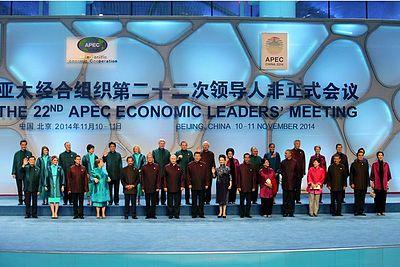US-China Agreement on Climate Change
The bilateral Joint Announcement on Climate Change Agreement released by the US and China on 11 November on the sidelines of the APEC Meeting in Beijing has imparted a new momentum to the troubled negotiations towards a post-Kyoto global emissions control agreement expected to be agreed at the UNFCCC Summit in Paris in December 2015. Both countries, together accounting for over 41% of global emission flows (China 25%, USA 16%), announced deeper emissions cuts than they have so far, sparking hopes of higher emission reduction commitments by other countries and a more positive outcome in Paris next year. The US and China agreed that the two countries would adopt enhanced targets for reducing emissions over the first decade, and more, after the yet to be agreed new international Agreement comes into effect in 2020.
China has for the first time declared that it would cap its absolute emissions by “around 2030”, and attempt to achieve this even earlier, along with announcing a target of 20% non-fossil fuel energy by that year. On its part, the US declared it would cut its emissions by 26-28% by 2025 relative to 2005, President Obama thus going beyond the cuts legislated several years ago by the US Congress. Both the US and China have raised their emission reductions commitments compared to those contained in the Cancun Summit decisions, the US from the legislated 17% reduction by 2020 relative to 2005 and China from an emissions intensity (ratio of emissions to GDP) reduction (not a reduction of absolute emissions) of 40-45% by 2025 below 2005 levels.

Image Courtesy:en.wikipedia.org
The Announcement has been greeted with some excitement around the world as a major step forward towards Paris. The US in particular has tom-tommed the Announcement as a great victory for American diplomacy, with edit page articles by no less than former Presidential hopeful and current Secretary of State John Kerry, and the Announcement itself being headlined on the White House website. China on the other hand has adopted a more muted position with little official fanfare, perhaps aware of the limitations of this bilateral agreement. While the announcement is certainly an advance compared to earlier positions of the two countries, and any forward movement in the climate negotiations is to be welcomed especially when weighed against the dismal progress so far, the Announcement raises several significant concerns.
Weak US commitment
The position put forward by the Obama administration in the Announcement is not much of an advance over the emission reduction target under the so-called Waxman-Markey legislation in the US Congress, and the corresponding pledges made by the US at Copenhagen in 2009 and at Cancun the following year. The US’ Cancun pledge would, by extrapolation, have meant around 30% emission reduction by 2030 from 2005 levels. Considering that the Kyoto Protocol required the US to reduce its emissions by 5.6% compared to 1990 levels by 2008, and that US emissions had actually risen 14% in that period, the earlier US commitment amounted to only a 3% cut compared to 1990 levels and that too 12 years later than originally promised! The current pledge therefore means only that the US will reduce its emissions in 2020 by 12-14% compared to 1990 levels.
This is shamefully lower than the 40% reduction by developed (so-called Annex-1) countries from 1990 levels by 2020 as called for by the IPCC and other scientific organizations and think tanks, and is also much lower than the 30% reduction below 1990 levels committed by the 28-member EU. Given the legislation on the books, the Obama administration will have to rely on executive actions to achieve even this low-ambition target, itself made easier by the discovery and rapid exploitation of shale gas in the US. The Republican Party, which now controls both Houses of Congress after the recent mid-term elections in the US, has already condemned the Obama administration’s Beijing announcement as a “sell-out” and will undoubtedly obstruct executive branch decisions all the way. Clearly, the new US pledge is highly inadequate, continues to bring up the rear among developed countries and is only a minor improvement over its earlier pledges.
China’s new target
China’s pledge in the Joint Announcement to peak “around 2030,” is undoubtedly significant, in that it is the first time that China has accepted a peaking year, something which it vigorously resisted at Copenhagen on the grounds that to do so would cede atmospheric carbon space to the developed countries. This new Chinese position has not come as a surprise, however, and has been evolving over the recent past, spurred on by the unbearable pollution in Chinese cities due clearly to proliferation of coal-based power plants in the vicinity, industrial emissions and excessive use of automobiles.
In terms of quantum of emissions reduction, however, the Chinese pledge may not be significantly higher than earlier targets, and might also not contribute a great deal to tackling the global climate crisis.
Firstly, this is because China has not specified what its peak-level annual emissions will be, or when its emissions will begin to decline after peaking, or to what level of annual emissions. China’s per capita annual emissions are already around 7 tonnes CO2-equivalent (combined figure for all greenhouse gases reduced to their equivalent amounts of carbon dioxide), less than half of US levels, but still more than 3 times higher than the 2 tonnes per capita per year global average prescribed by scientists to maintain the global target of staying below 2 degrees C temperature rise. (India’s current annual per capita emissions are under 2 tonnes CO2-eq.) By the peaking year of 2030, it is estimated that China’s annual per capita emissions may be over 10 tonnes CO2-eq.
Secondly, climate analysts and policy experts in China itself, such as the authoritative China Academy of Social Sciences and several climate think tanks had estimated much earlier that China’s emissions would peak around 2030-2035 and start to decline by 2040 even under a business-as-usual scenario.
Thirdly, while the Chinese pledge to have 20% of its energy production come from non-fossil sources (including nuclear and hydro) by 2030 is impressive by any standards especially in absolute terms, considering that it means adding 800-1000 GigaWatts (1GW=1000 MW) of non-fossil energy by 2030, it too is not very different from previously declared targets. China is already working to a plan to reach 15% renewable energy production by 2020, so an additional 5% in 10 years is not as ambitious as it may appear at first sight. Incidentally, India’s Low Carbon Committee too has projected that India too could have about 30% installed capacity in solar and wind by 2030, although this might amount to only around 14% of electricity supply.
Inadequacy for global targets
Thus, while the US-China Joint Announcement is undoubtedly a step forward compared to earlier pledges by both countries, and may symbolically exert pressure on other countries towards greater ambition on emissions reduction commitments, the combined reductions promised are insufficient in comparison with the magnitude of the task ahead.
Climate scientists and think tanks have estimated that these commitments by the US and China together will not contribute enough to global emission reductions to materially help achieve the 2 degree C target. Certainly, if other developed countries such as Australia, Japan and Canada, “transitional” economies such as Russia and other Eastern European countries, countries on the cusp such as South Korea, Taiwan and Mexico, or developing countries with high emissions such as India, Brazil, South Africa, Argentina, Indonesia and several SE Asian nations, all follow the lead of the US and China regarding level of ambition, it is almost certain that climate-related temperature rise will cross the 2 degrees C threshold and is likely to reach 3.5°C or more even by mid-century.
Architecture of post-Kyoto Agreement
It is also significant that the US-China Announcement, while declaring emission reduction targets, is silent on the architecture of the post-Kyoto emissions control regime envisaged to be finalized at the Paris Summit in December 2015. If the 2 degree C goal is to be achieved, then some kind of prescriptive or “top-down” architecture will be essential. However, the US is pushing hard for a “bottom-up” pledge-and-review system where countries set self-declared emission reduction commitments that may or may not add up to the cuts required to achieve the 2 degrees C goal. Such a system has been in place since Copenhagen, ratified at Cancun, and many observers feel such a structure may eventually prevail at Paris too, simply because it is convenient to all large emitters and avoids possibly onerous targets. The peril, however, is that such a structure may only drive what has been termed a “race to the bottom,” that is, low national targets which cumulatively would leave the people staring at a 3-4 degree C temperature rise by mid-century with horrendous impacts especially on developing countries, island nations and the poor in general. If the US-China joint Announcement is indeed a sign that both countries have decided on a pledge-and-review architecture and will push for the same at Paris, that is troubling indeed. Any agreement in Paris must pass the test of adequacy to meet the 2°C goal and must also allow for upward revision of self-set pledges if found to be inadequate. So far one has only seen pledges, and not enough review of what these pledges amount to.
It is also noteworthy that the US-China Joint Announcement makes no mention of equity as a guiding principle in determining the architecture of an international emissions control regime comprising national commitments. Combined with a pledge-and-review system in which developed countries can evade historic responsibility and adopt low targets incommensurate with either their contribution to the problem or the 2°C goal, this will further undermine the ethical principles on which the UN Framework Convention is founded and which have been the bedrock of international negotiations for over two decades.
It is to be hoped that the US-China Joint Announcement is only the beginning of a process of setting national emission reduction commitments based on adequacy to meet the 2°C goal, rather than the last word on the subject by these countries, and that the targets declared by the US and China are the floor rather than the ceiling as the world heads to Paris.
What will India do?
Lastly, it may also be noted that India, as always, continues to bring up the rear in the climate negotiations. There are rumours that Indian officials too are working on announcing some revised targets, perhaps by mid-2015. In the absence of wider consultations or any policy statements as to intentions and current thinking, on the contrary given the increasingly conservative policy stances on climate change and other environmental issues, one can only assume the worst.
No new idea to operationalize equity, no initiative that would put pressure on developed countries to adopt deeper cuts, no sign that India would itself make ambitious contributions to this global problem, no effort to take a position of leadership in tackling this global crisis, and especially no attempt to make common cause with least Developed Countries, African countries and the developing Island States. While the BJP-led government has been making noises about distancing India from China, the latter has in fact moved ahead to strike bilateral deals especially with the US as feared by many.
It is still not too late for India to take new initiatives although time is rapidly running out and India will very soon become irrelevant, fighting rearguard defensive actions, contributing only to semantic quibbling at international negotiations, and seen mainly as a petulant nuisance factor while others deal with pressing in a substantive way.
The more things change, the more they remain the same.
Disclaimer: The views expressed here are the author's personal views, and do not necessarily represent the views of Newsclick
Get the latest reports & analysis with people's perspective on Protests, movements & deep analytical videos, discussions of the current affairs in your Telegram app. Subscribe to NewsClick's Telegram channel & get Real-Time updates on stories, as they get published on our website.























